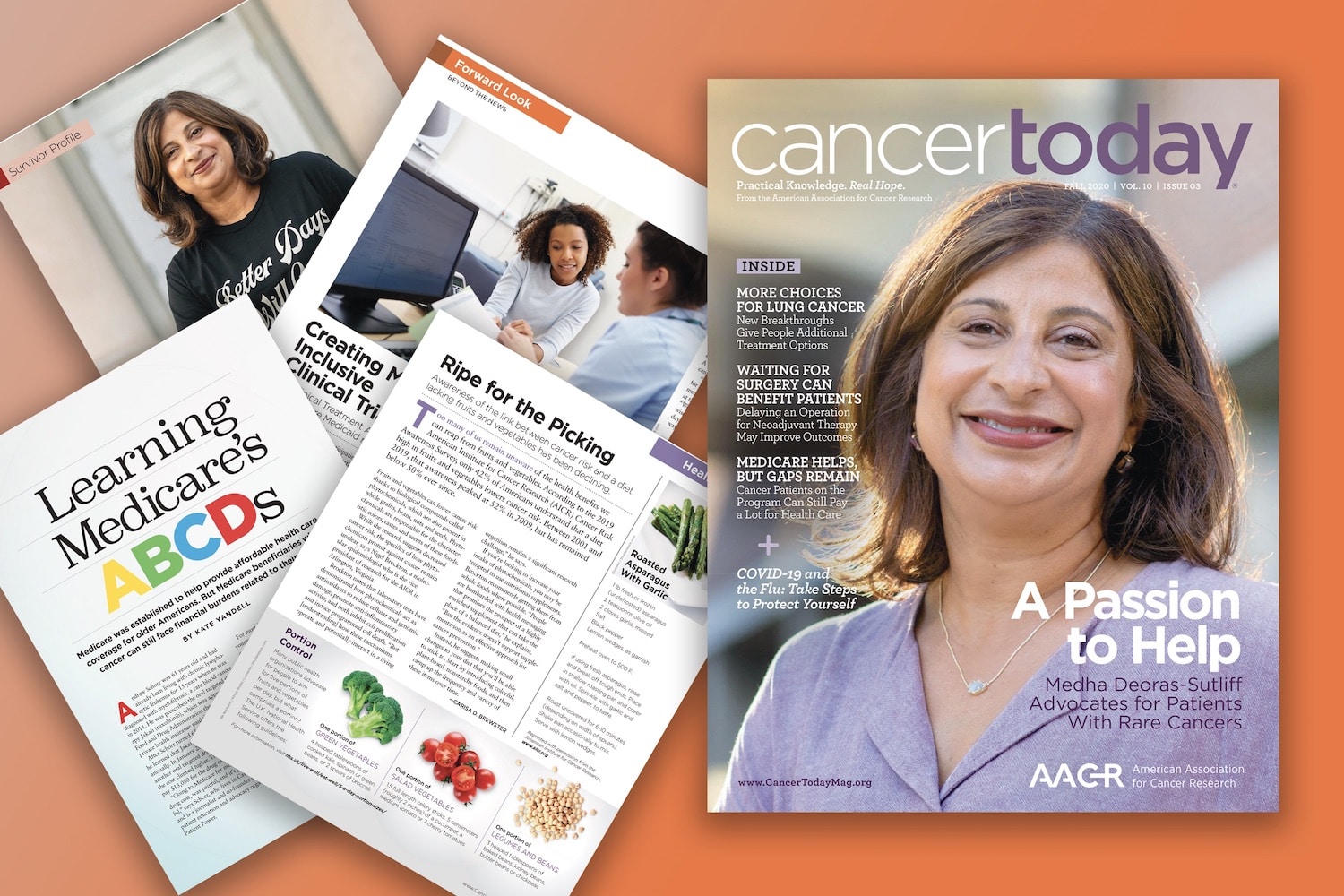Cancer Diagnoses and Research Continue
Amid the ongoing pandemic, Cancer Today continues to cover cancer research and treatment while also reporting on the many ways COVID-19 has impacted people with cancer.
by Kevin McLaughlin
September 21, 2020
Planning for the fall issue of Cancer Today, which was released Sept. 18, began six months earlier, in March, as schools and workplaces across the U.S. were shutting down their on-site operations due to COVID-19. Since then, virtual learning and work from home have become the norm for millions of Americans. The Cancer Today staff is no exception: We have been working remotely since mid-March, with only occasional staff visits to the Philadelphia office of the American Association for Cancer Research (AACR), which publishes Cancer Today.
While much has changed in our lives since March, one thing remains the same: People are still being diagnosed with cancer and getting treated for their disease. In the fall issue and on the Cancer Today blog, we continue to write about cancer, while acknowledging and reporting on myriad ways that COVID-19 has affected cancer patients and survivors.
In the magazine, Hester Hill Schnipper writes about patients setting boundaries in their personal relationships during treatment, with a COVID-19 twist. Among her recommendations that never would have occurred to us before March are: “Share your expectations for social distancing before visits” and “say ‘no’ to invitations if you feel any hesitation to attend, including if you have any concerns that you might be exposed to the coronavirus.”
Head and neck surgeon Karthik Rajasekaran of the University of Pennsylvania Perelman School of Medicine in Philadelphia offers advice on how patients can get the most out of telemedicine appointments. Among his commonsense suggestions: For video calls, sit in a well-lit location with the computer or smartphone raised up to eye level. And be sure to “dress so it will be easy for the doctor to see and examine you as needed on camera.”
As COVID-19 continues to flare up in the U.S. and around the world, hope resides in researchers working to find safe and effective vaccines and treatments that will protect us from the disease. Meanwhile, cancer research continues. Kendall K. Morgan reports on targeted treatments for non-small cell lung cancer, which makes up 80% to 85% of lung cancer diagnoses. Tumor testing to identify mutations that could lead to effective treatments is rapidly become a standard step in diagnosis. “We’re providing more options for more patients with better quality of life and longer survival,” says Gregory Masters, an oncologist at the Helen F. Graham Cancer Center and Research Institute in Newark, Delaware. “It’s not all patients—there’s still work to do—but it is a time of optimism for treating lung cancer and for patients.”
From one of the most common cancers to one of the rarest: Epithelioid hemangioendothelioma (EHE) affects just one in a million people. Despite EHE’s rarity, breast cancer survivor Medha Deoras-Sutliff has made it her mission to support research that could lead to new treatments for this illness. Lindsey Konkel describes Deoras-Sutliff’s journey from diagnosis and treatment to patient advocacy. Her fascination with research into rare cancers led her to become executive director of the EHE Foundation, a nonprofit dedicated to finding new treatments for the disease.
One of the oldest treatments for solid-tumor cancers is removing the tumors via surgery. An operation’s effectiveness against cancer depends largely on how far the disease has advanced, but researchers are seeking to maximize effectiveness and minimize side effects via neoadjuvant therapy—chemotherapy, hormone therapy or radiation deployed before surgery. Sharon Tregaskis reports on research showing that some patients receiving neoadjuvant therapy have better surgical outcomes, including improved quality of life and longer periods of remission and survival, than patients who undergo these treatments after surgery.
In this presidential election year, the high cost of health care has been an important campaign issue. Research indicates that older cancer patients, who are eligible for Medicare, tend to have lighter financial burdens from treatment than younger patients. However, Kate Yandell reports that limitations in Medicare coverage can still lead to hefty bills for cancer patients counting on the federal program to help them pay for expensive treatments. “Cancer really unfortunately is kind of the perfect example of how the benefit falls short in providing financial protection that people really need in order to continue to take the medications that they need,” says Juliette Cubanski, deputy director of the Program on Medicare Policy at the Kaiser Family Foundation in San Francisco.
While COVID-19 dominated the news this year, another issue burst onto the scene and demanded our attention: the pervasive racism and injustice toward Black Americans and members of other minority groups in the U.S. The killing of George Floyd by Minneapolis police, and similar killings and acts of violence, exposed for many Americans the racism underpinning much of our society. The COVID-19 pandemic laid bare disparities in health care treatments and outcomes for Black Americans and members of other minority groups compared to white Americans. These disparities extend to other serious diseases, including cancer. In his column, Cancer Today editor-in-chief William G. Nelson discusses the AACR Cancer Disparities Progress Report 2020, published this fall by the AACR. The report chronicles disparities in cancer care and treatment faced by members of racial and ethnic minorities in the U.S. and calls for an end to these differences through research and public policy initiatives. Nelson, director of the Johns Hopkins Kimmel Cancer Center in Baltimore, echoes the call of the Healthy People 2020 initiative to create environments that promote good health for everyone, adding, “Meaningful progress toward this goal will not only reduce cancer incidence and mortality but promote greater equity in outcomes for cancer and other dread diseases.”
Kevin McLaughlin is the executive editor of Cancer Today.
Cancer Today magazine is free to cancer patients, survivors and caregivers
who live in the U.S. Subscribe here to receive four issues per year.





